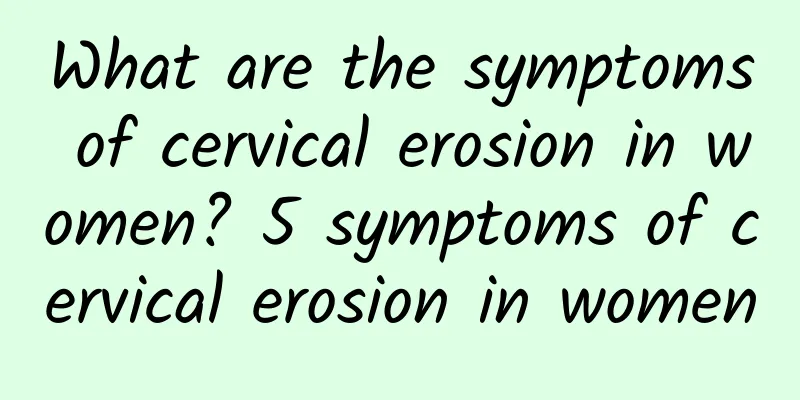What are the symptoms of cervical erosion in women? 5 symptoms of cervical erosion in women

|
Cervical erosion is a common gynecological disease in women. After suffering from cervical erosion, the body will have some obvious symptoms. What are they? The squamous-columnar junction is easily affected by estrogen. Before puberty, women's ovarian function is not perfect, estrogen is low, and the columnar epithelium is closer to the inside. After menstruation, the columnar epithelium is affected by estrogen and develops more toward the outside. Therefore, more columnar epithelium similar to "erosion" is found during cervical examination. After menopause, women's estrogen levels decrease, and the columnar epithelium begins to retreat inward. At this time, the "erosion" is no longer visible during examination. Therefore, in essence, the so-called cervical erosion is actually the eversion of the columnar epithelium. 1. Infertility: When a woman's vaginal discharge becomes thick and sticky, sperm cannot penetrate, causing cervicitis and making it impossible to get pregnant. 2. Frequent urination or difficulty urinating: Once the inflammation affects the triangular area or the surrounding area of the bladder, the patient will experience frequent urination or difficulty urinating. 3. Vulvar itching and pain: When the patient's leucorrhea increases, the vulva and vagina will be irritated, making women very likely to suffer from vulvitis or vaginitis. Therefore, women are very likely to experience vaginal itching and pain. 4. Increased vaginal discharge: This symptom is the most common symptom of cervical erosion. Generally, when the disease occurs, the vaginal discharge is milky white or light yellow purulent secretions, and sometimes bleeding and blood streaks will occur. 5. Pain in the lower abdomen and lumbosacral region: When the inflammation suffered by women is very serious, the inflammation will begin to spread along the uterosacral ligament and the main ligament, thus making the pelvic connective tissue inflammation worse, causing pain in the lower abdomen or lumbosacral region of female patients, accompanied by a feeling of falling. Women will have many symptoms after suffering from cervical erosion. Generally speaking, women with cervical erosion will often have increased vaginal discharge and lower abdominal pain, which are common symptoms of cervicitis. |
<<: What are the ways to care for female cervical erosion? 6 ways to prevent female cervical erosion
Recommend
What is the treatment method for painless abortion?
What is the treatment method for painless abortio...
The "intermittent fasting" weight loss method is very popular, how to eat effectively? Protein is essential, experts teach you how to eat it more
If you want to lose weight, you can eat like this...
Simple analysis of drug abortion
Many people think that contraceptive rings and ot...
How much do you know about the treatment of pelvic inflammatory disease?
Pelvic inflammatory disease is a common disease, ...
What is the cause of the lower abdominal pain 5 days after the miscarriage?
What happened to my lower abdomen pain 5 days aft...
What medicine is good for uterine fibroids? How to use medicine for uterine fibroids
The exact cause of uterine fibroids is still uncl...
What should I pay attention to when getting cervical warts?
What are the measures to prevent cervical warts? ...
How many days should I rest after painless abortion?
Painless abortion refers to painless artificial a...
Ectopic pregnancy may be caused by maldevelopment of the fallopian tube
Ectopic pregnancy may be caused by dysplasia of t...
What happens if cervical precancerous lesions are not treated?
For patients with cervical precancerous lesions, ...
What is the main cause of dysmenorrhea?
Female dysmenorrhea is very common in daily life,...
What is the trick to treat vulvar leukoplakia?
Symptoms of vulvar leukoplakia include whitening ...
What should I do if my menstrual flow is light?
What should I do if my menstrual flow is light? L...
Fat zebrafish have amazing uses! New model for screening weight loss pills
Obesity is the biggest invisible killer affecting...
Can I eat snacks after abortion?
You can eat snacks after an abortion, but be care...









